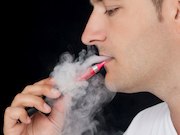The more chemicals in e-liquid, the more toxic it is likely to be; vanillin tied to higher toxicity
WEDNESDAY, March 28, 2018 (HealthDay News) — The e-liquids used in electronic cigarettes (e-cigarettes) are a heterogeneous group, and there is a positive correlation between the number of chemicals contained in the liquid and the likelihood of its toxicity, according to a study published online March 27 in PLOS Biology.
Noting that most of the 7,700 e-liquid flavors available have not been tested for toxicity in the laboratory, M. Flori Sassano, Ph.D., from the University of North Carolina at Chapel Hill, and colleagues developed a three-phase, 384-well, plate-based, high-throughput screening assay to triage and validate the toxicity of multiple e-liquids.
The researchers found that the propylene glycol (PG)/vegetable glycerin (VG) vehicle had an adverse effect on cell viability and that many of the e-liquids were more toxic than PG/VG. All tested e-liquids were analyzed with gas chromatography-mass spectrometry; in non-metric multidimensional scaling analysis, e-liquids were found to be extremely heterogeneous. The more chemicals in an e-liquid, the more toxic it was likely to be; in addition, vanillin was associated with elevated toxicity values. There was a correlation for the concentration of cinnamaldehyde and vanillin, but not triacetin, with toxicity.
“Our data suggest a high-throughput screening approach to evaluate the toxicity of multiple e-liquids is feasible,” the authors write. “Such an approach may serve as a roadmap to enable bodies such as the U.S. Food and Drug Administration to better regulate e-liquid composition.”
Copyright © 2018 HealthDay. All rights reserved.








